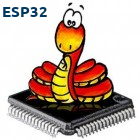-
Notifications
You must be signed in to change notification settings - Fork 345
onewire
This class includes full support for Onewire devices using the ESP32 RMT peripheral to achieve very precise timing
1-Wire is a device communications bus system designed by Dallas Semiconductor Corp. that provides low-speed data, signaling, and power over a single conductor.
1-Wire is similar in concept to I²C, but with lower data rates and longer range. It is typically used to communicate with small inexpensive devices such as digital thermometers and weather instruments. A network of 1-Wire devices with an associated master device is called a MicroLAN.
One distinctive feature of the bus is the possibility of using only two wires: data and ground. To accomplish this, 1-Wire devices include an 800 pF capacitor to store charge, and to power the device during periods when the data line is active.
| ESP32 | Device |
|---|---|
| any ouput capable port External pull-up resistor (1K - 4.7K) to +3.3V is needed |
D (data pin) |
| GND | GND |
| +3.3V | Vdd (optional) |
The 1-wire devices can be connected in two power modes:
-
Normal power, +3.3V is connected to the device's Vdd pin

-
Parasite power, device's Vdd pin is connected to the GND pin, the needed power is supplied by the data pin

- The used Power mode is detected automatically by the driver
- All devices connected to the same 1-wire bus must operate in the same mode
The new 1-wire bus is created on ESP32 gpio pin.
The bus is scanned for attached devices.
>>> import machine
>>>
>>> ow = machine.Onewire(25)
>>> ow
Onewire(Pin=25, RMTChannels=7&6, Devices=2, Used=0)Deinitialize the 1-wire bus and free the used resources.
Scan 1-wire bus for attached devices.
Returns the tuple of detected devices ROM codes.
Optional asnum argument defines the format of the rom code returned.
If False (default), the rom code is returned as hex string.
If True, the rom code is returned as tuple: (family_code, serial_number, crc)
>>> ow.scan()
('6e000000c86a8e28', '02000000c82a8928')
>>> ow.scan(True)
((40, 13134478, 110), (40, 13118089, 2))Same as ow.scan.
Return the ROM code of the device dev as hex string.
>>> ow.rom_code(0)
'6e000000c86a8e28'Returns the crc8 checksum byte for the buf argument
>>> ow.crc8('123456abcdef')
12
>>> buf = bytearray([0x11,0x12,0x13,0x67,0xf7])
>>> ow.crc8(buf)
227The following low-lewel methods can be used
to implement Python drivers for various 1-wire devices.
Read one byte from the 1-wire device.
write one byte val to the 1-wire device.
Read len bytes from the 1-wire device.
Returns string of read bytes.
Write multiple bytes to 1-wire device from string or bytearray buf.
